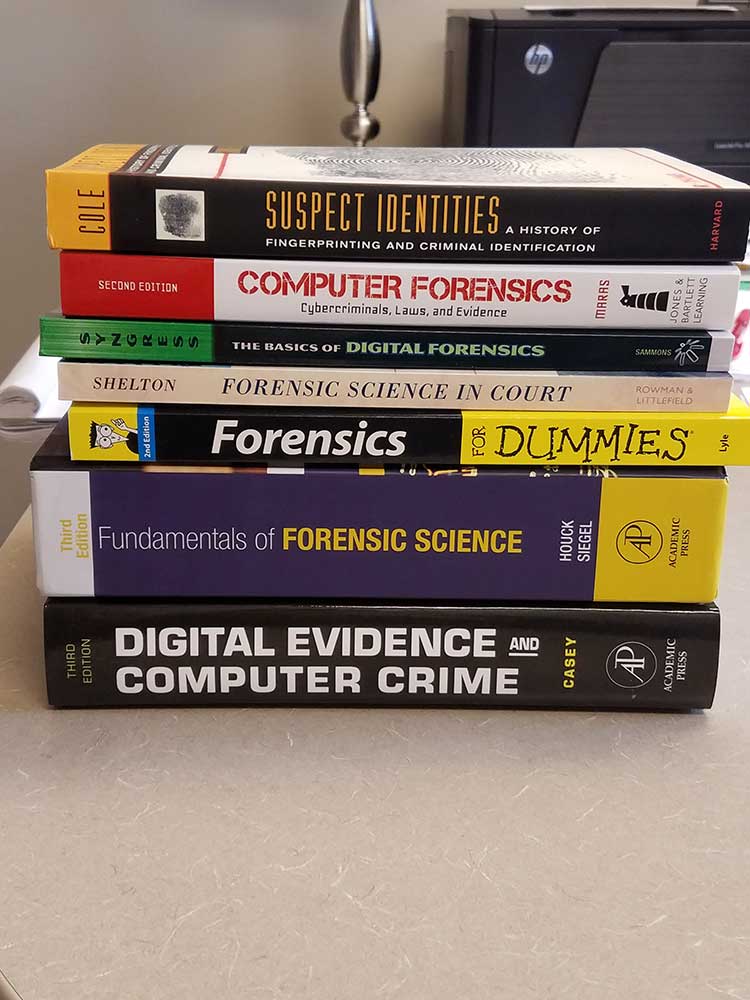Bullet matching is a process used to determine whether two bullets may have been fired from the same gun barrel. Historically, this has been a manual process performed by trained forensic examiners. Recent work, however, has shown that it is possible to add statistical validity and objectivity to the procedure. In this article, we build upon the algorithms explored in Automatic Matching of Bullet Lands (Hare, Hofmann & Carriquiry (2017), Automatic matching of bullet lands. ArXiv E-Prints) by formalizing and defining a set of features, computed on pairs of bullet lands, which can be used in machine learning models to assess the probability of a match. We then use these features to perform an analysis of the two Hamby (Hamby, Brundage & Thorpe (2009), The identification of bullets fired from 10 consecutively rifled 9 mm Ruger pistol barrels: a research project involving 507 participants from 20 countries. AFTE J., 41, 99–110) bullet sets (Set 252 and Set 44), to assess the presence of microscope operator effects in scanning. We also take some first steps to address the issue of degraded bullet lands and provide a range of degradation at which the matching algorithm still performs well. Finally, we discuss generalizing land-to-land comparisons to full bullet comparisons as would be used for this procedure in a criminal justice situation.
Cross-Domain Forensic Shoeprint Matching
We investigate the problem of automatically determining what type of shoe left an impression found at a crime scene. This recognition problem is made difficult by the variability in types of crime scene evidence (ranging from traces of dust or oil on hard surfaces to impressions made in soil) and the lack of comprehensive databases of shoe outsole tread patterns. We find that mid-level features extracted by pre-trained convolutional neural nets are surprisingly effective descriptors for these specialized domains. However, the choice of similarity measure for matching exemplars to a query image is essential to good performance. For matching multi-channel deep features, we propose the use of multi-channel normalized cross-correlation and analyze its effectiveness. Finally, we introduce a discriminatively trained variant and fine-tune our system end-to-end, obtaining state-of-the-art performance.
Statistical Analysis of User-Event Data in a Digital Forensics Context
Analyzing User-Event Data Using Score- Based Likelihood Ratios with Marked Point Processes
In this paper we investigate the application of score-based likelihood ratio techniques to the problem of detecting whether two time-stamped event streams were generated by the same source or by two different sources. We develop score functions for event data streams by building on ideas from the statistical modeling of marked point processes, focusing in particular on the coefficient of segregation and mingling index. The methodology is applied to a data set consisting of logs of computer activity over a 7-day period from 28 different individuals. Experimental results on known same-source and known different-source data sets indicate that the proposed scores have significant discriminative power in this context. The paper concludes with a discussion of the potential benefits and challenges that may arise from the application of statistical analysis to user-event data in digital forensics.
Changed Science Statutes: Can Courts Accommodate Accelerating Forensic Scientific and Technological Change?
In the past several years, the nation’s two most populous states have passed new statutes specifically intended to address the issue of rapidly changing scientific and technological knowledge, perhaps signaling a national trend. This reflection article situates a discussion of these “changed science statutes” within a sociological understanding of the nature of scientific knowledge, exploring the question of what it means for scientific knowledge to “change.” It then traces the procedural history of the two cases widely credited with prompting the passage of the statutes and courts’ varying interpretations of the statutes. It suggests that, while changed science statutes offer broad potential for redressing the use of impugned science in closed cases, courts have thus far limited their applicability through narrow interpretation of the statutes.
Evaluating Negative Forensic Evidence: When Do jurors Treat Absence of Evidence as Evidence of Absence?
Hydrodynamics of back spatter by blunt bullet gunshot with a link to bloodstain pattern analysis
A theoretical model describing the blood spatter pattern resulting from a blunt bullet gunshot is proposed. The predictions are compared to experimental data acquired in the present work. This hydrodynamic problem belongs to the class of the impact hydrodynamics with the pressure impulse generating the blood flow. At the free surface, the latter is directed outwards and accelerated toward the surrounding air. As a result, the Rayleigh-Taylor instability of the flow of blood occurs, which is responsible for the formation of blood drops of different sizes and initial velocities. Thus, the initial diameter, velocity, and acceleration of the atomized blood drops can be determined. Then, the equations of motion are solved, describing drop trajectories in air accounting for gravity, and air drag. Also considered are the drop-drop interactions through air, which diminish air drag on the subsequent drops. Accordingly, deposition of two-phase (blood-drop and air) jets on a vertical cardstock sheet located between the shooter and the target (and perforated by the bullet) is predicted and compared with experimental data. The experimental data were acquired with a porous polyurethane foam sheet target impregnated with swine blood, and the blood drops were collected on a vertical cardstock sheet which was perforated by the blunt bullet. The highly porous target possesses a low hydraulic resistance and therefore resembles a pool of blood shot by a blunt bullet normally to its free surface. The back spatter pattern was predicted numerically and compared to the experimental data for the number of drops, their area, the total stain area, and the final impact angle as functions of radial location from the bullet hole in the cardstock sheet (the collection screen). Comparisons of the predicted results with the experimental data revealed satisfactory agreement. The predictions also allow one to find the impact Weber number on the collection screen, which is necessary to predict stain shapes and sizes.
A Fully Automatic Method for Comparing Cartridge Case Images
When a gun is fired, it leaves marks on cartridge cases that are thought to be unique to the gun. In current practice, firearms examiners inspect cartridge cases for “sufficient agreement,” in which case they conclude that they come from the same gun, testifying in courts as such. A 2016 President’s Council of Advisors on Science and Technology report questioned the scientific validity of such analysis (President’s Committee of Advisors on Science and Technology, Washington, DC, Executive Office of the President). One recommendation was to convert firearms analysis to an objective method. We propose a fully automated, open‐source method for comparing breechface marks on cartridge cases using 2D optical images. We improve on existing methodology by automating the selection of marks, and removing the effects of circular symmetry. We propose an empirical computation of a “random match probability” given a known database, which can be used to quantify the weight of evidence. We demonstrate an improvement in accuracy on images from controlled test fires.
The Crime Lab in the Age of the Genetic Panopticon
3 Top Universities For Forensic Science Programs
A CSAFE Partner School Spotlight
One of the core research areas at CSAFE is training and education. The next generation of forensic scientists, laboratory technicians and other practitioners in the forensic community are vital to the innovation and integrity of the forensic field and to our country’s justice overall. We are proud to be partnered with institutions that are preparing this next generation of forensic scientists, and we look forward to working in collaboration and spreading the advancement of forensic sciences from practicing forensic scientists to those aspiring to join the field.
1. Albany State University | Albany, Georgia
Albany State University offers a Bachelor of Science in Forensic Science within a challenging academic environment. Its program is accredited by the Forensic Science Education Program Accreditation Commission of the American Academy of Forensic Sciences. Students receive fundamental scientific knowledge, laboratory and analytical skills, communication skills and ethical principles through their studies and hands-on experiences. The program integrates research activities focused on forensic areas such as programming, data analysis, real-time instrument control and project planning.
Students should consider the forensic BS program at Albany State University if they are seeking careers in:
- Forensic chemistry
- Forensic microscopy
- Forensic toxicology
- Forensic photography
- Forensic fingerprinting
- Forensic DNA
In collaboration with CSAFE, Albany State University forensic science faculty are working to elevate their program to even greater heights and to advance the overall level of forensics education in the country.
2. Fayetteville State University | Fayetteville, North Carolina
The Bachelor of Science program in Forensic Science at Fayetteville State University helps students develop their technical skills, and their basic foundational science and laboratory problem-solving skills. The program touches on areas such as DNA analysis, forensic chemistry and trace evidence. Students will also learn how to prepare reports, document their findings and their laboratory techniques, and communicate their findings. Upon graduation, students are prepared to contribute to a modern crime laboratory — as well as help advance the forensic science community overall.
Students can choose between one of two concentrations:
- Forensic biology
- Forensic chemistry
In collaboration with CSAFE, the professors and faculty in the forensics program at Fayetteville State University aspire to provide their students with the latest training in forensic techniques and models, and to foster innovation among its students.
3. Eastern New Mexico University | Portales, New Mexico
The forensic science program offered at Eastern New Mexico University develops the technical talents of students as well as their ability to critically think and actively synthesize information. The program adheres to the Forensic Science Education Programs Accreditation Commission standards. Students will learn from practitioners at the local, state and national levels, and they will gain both theoretical and practical experience within classrooms and laboratories.
Within the Bachelor of Science in Forensic Science program, students can concentrate their studies in one of three emphasis areas:
- Forensic biology
- Forensic chemistry
- Forensic anthropology
The school has plans to add digital forensics in the near future, and its collaboration with CSAFE will help it better achieve its goal by staying on the cutting edge of digital forensic practices.
Does your school’s forensic science program have a passion for the advancement of the forensic science industry? Do you want to not only stay on the cutting edge of forensic technology — but help lead it? Contact CSAFE today.






